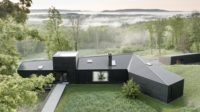New York City
A husband-and-wife team has gone back to basics, studying the material and structural innovations of centuries past to create new systems for building.
Lonn Combs and Rona Easton, married in life as well as in practice, have spent the last year living and working in Rome. Combs won a Rome Prize in Architecture in 2011 and, with Easton, has been studying Italian architect and engineer Pier Luigi Nervi’s groundbreaking innovations with concrete. In a way, their time in Rome has been a mirror of their practice in recent years. Just as they are taking the time now to “slow down and learn to walk again,” Combs says they decided a few years ago to narrow their focus to the essentials: studying materials, structural performance, and assembly.
In the reverse order of most independent architects’ trajectories, the couple’s collaboration officially began with their largest built project to date, a parking facility (2005) for George Bush Intercontinental Airport in Houston. Someone familiar with the architects’ work connected them with the developer of the project. “He was willing to listen to us in terms of design ideas,” says Combs in explaining the imaginative result. Their shift to a smaller scale began around the time the architects competed in the 2010 MoMA PS1 Young Architects Program, which they did not end up winning. For the temporary installation that PS1 builds each summer in its courtyard in Queens, New York, they proposed a cluster of colorful parasols made of extruded cellular-polycarbonate blades. “The challenge of imagining the design is one thing; building it yourself, and efficiently, is another,” says Combs. “[PS1] opened up a focus on smaller installations and ways we could do our own building. It’s been an interesting area of research, and it strengthened our outlook.” That research led to two projects in 2011 that explored lightweight structural membranes: a temporary concept showroom for Ohne Titel, a New York–based fashion label, and an installation called Changing Room in Chicago’s Extension Gallery for Architecture.
Combs and Easton, who met while working in Berlin during the building boom of the early 1990s, are now slowly growing back up in scale, with many projects on the boards “that we didn’t anticipate in the last 18 months,” says Combs. Speaking from Rome—the research period ended in July, but Combs has been teaching a fall studio at Rensselaer Polytechnic Institute’s program abroad—the couple described a sleepless week as they prepared to enter a competition for an EU school in Crete. Their bioclimatic design strategy uses passive systems and explores prefabrication. They are also working on a prototype of a house with similar parameters. Easton says the duo’s Nervi studies will come into play for the house (requested by a client who may build in Colorado), because it uses precast concrete.
As Easton and Combs prepare to come home, they say that stepping back, both physically and in their practice, has increased their confidence. “It’s been a revelation in many ways,” says Easton. “It’s easy to look at the history of architecture and see beauty but something that’s not relevant to you now. Being in Rome has fundamentally changed the way I think about that. You realize that 1,000 or 2,000 years is no time at all.”
Easton+Combs
FOUNDED: 2004
DESIGN STAFF: 4
PRINCIPALS: Rona Easton, Lonn Combs
EDUCATION: Easton: University of Westminster, Dip.Arch., 1989; University College London, MScAAS, 1987. Combs: Columbia University, MSAAD, 2001; University of Kentucky, B.Arch., 1992.
WORK HISTORY: Easton: RMJM, 1997–98; BDP, 1993–97. Combs: SOM, 1999–2000; Kleihues+Kleihues, 1994–97; Studio Daniel Libeskind, 1992–94.
KEY COMPLETED PROJECTS: Ohne Titel Concept Showroom, New York City, 2011; Changing Room, Chicago, 2011; IAH Airport Parking, Houston, 2005
KEY CURRENT PROJECTS: Passive House Case Study, 2012 (ongoing); EU School, Crete, Greece, 2012 (design study)
WEB SITE: www.eastoncombs.com
People |
Products |









Post a comment to this article
Report Abusive Comment